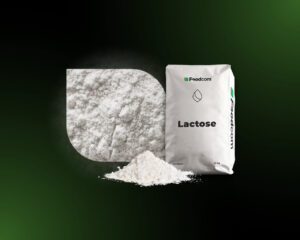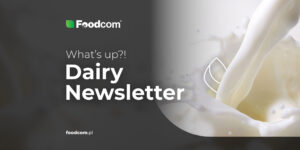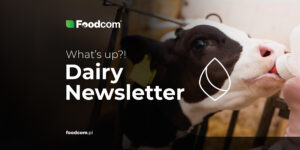- Prices of milk fat, including butter and cream, are rising sharply due to limited availability of raw materials and high temperatures.
- The milk powder (SMP) market is stable with a clear upward trend and limited product availability.
- Despite the seasonal peak in milk production, there is a decline in availability and rising spot prices.
- The whey market remains difficult, with high supply offset by weak demand, leading to further price declines, especially in the feed segment.
Welcome Partners!
Welcome back to our newsletter!
The end of the seasonal peak in milk procurement in Northern European countries has brought significant price changes across the dairy chain. Restrictions on raw material availability, higher temperatures and dynamic weather conditions mean that purchasing liquid components now requires greater effort – both logistically and financially.
We are seeing a further strengthening of the milk fat market, an increase in the price of concentrates and continued stability in the milk powder and cheese markets. Volatility and uncertainty continue to be the main features of the market – despite seasonally high milk production, the availability of some components is already starting to shrink.
Scroll down for detailed market data and forecasts.
Milk powder
The SMP market remains stable, but with a clear upward trend. Transaction prices have risen slightly, with spot levels currently in the 2400-2450 EUR/MT range, and producers signalling limited availability and short delivery times. Demand in the European market remains moderate, with relatively small differences between spot prices and Q3 futures (bids reach 2550 EUR/MT).
Similar dynamics are occurring in the feed market – we are seeing a strengthening of the market and an increase in prices for both standardised and unsorted products. Standardised bulk product is currently reaching levels of 2430-2440 EUR/MT, while offers for Q3 with DAP NL delivery are reaching 2450 EUR/MT. The market is characterised by moderate demand and a limited number of transactions.
Supplies of unsorted skimmed milk powder for feed purposes are experiencing increases, particularly in the July delivery market, where prices are emerging at 2460 EUR/MT DAP NL, indicating advance purchase activity and increasing interest in lower quality components.
Cheese
The cheese market remains stable and shows no signs of weakening. Gouda and Edam remain high at 4300-4400 EUR/MT and 4300-4350 EUR/MT respectively, with low supply pressure and continued demand, particularly from the retail sector. Mozzarella recorded an increase in prices last week, reaching levels of 4300-4400 EUR/MT, linked to an increase in seasonal demand and rising raw milk costs. Cagliata has also seen a slight increase in interest.
Fats
The butter market has clearly rebounded in recent days. Prices have risen sharply, with current trading levels in the 7300-7400 EUR/MT range (for 25kg blocks of fermented butter, prices reach 7350 EUR/MT and German 10kg blocks even reach 7450 EUR/MT), confirming a change in sentiment: buyers are starting to act precautionary, fearing further rises.
Cost pressures from expensive cream and the decreasing availability of milk fat at higher temperatures support this trend. The high price differential between cream and butter may stimulate production in the short term, but with current stocks and the contract policy of many buyers, the room for further increases may be limited.
Liquids
The cream market saw another increase, with prices jumping to around 8700 EUR/MT, approaching the levels quoted for butter, indicating tensions in the availability of milk fat. Higher temperatures are reducing milk fat yields, further sustaining the upward pressure. However, the situation could change quickly depending on the weather – forecast warming in the Netherlands, among others, could further affect supply.
SMC prices are rising in many countries, with particularly notable increases for products of German origin (2050-2150 EUR/MT FCA) and UK origin (above 2000 EUR/MT DAP NL), where prices have returned above 2000 EUR/MT. Supply remains limited and demand stable, resulting in a further upward trend.
Spot milk prices are rising – this is confirmed by both payment data in the Netherlands and general market signals. The seasonal peak is behind us and milk availability is decreasing week by week.
Whey powder
Food grade whey prices remain low, although the range of offers is wide, current levels are between 1030-1100 EUR/MT depending on the producer. For feed quality, we are seeing a further decline in prices, with bulk spot trade at 830 EUR/MT and offers with DAP NL delivery oscillating between 850-880 EUR/MT (Q3: 920-940 EUR/MT) – with little buying activity. The market remains challenging, with supply still high thanks to strong cheese production, but demand not keeping up.
Whey concentrate prices remain below 350 EUR/MT FCA. Despite attractive costs (often lower than feed whey alone), limited availability of in-plant dryers means that the product is not reaching the market in sufficient quantities.
The whey protein concentrate market in Europe is stable. Most of the purchases for Q3 have already been made, limiting current activity. Prices for instant WPC 80 remain at 12000 EUR/MT and US supplies are still competitively priced, although uncertainty around global trade makes both sides cautious.
Whey protein isolate prices in Europe are declining slightly and are now around 20000 EUR/MT. Demand has weakened, mainly due to early purchases and customer stocks. The US market situation remains more stable, but further developments will depend on the shape of trade relations with China.
The permeate market in Europe remains low but stable with prices around 790-830 EUR/MT. Supply is not an issue – the increase in WPC production means that the raw material is readily available. In the US, the market is under pressure – feedstock prices there are reaching 380-450 EUR/MT – as a result of trade tensions with China, resulting in attempts to sell off stocks more quickly.
Lactose prices in Europe remain high, at around 1300-1350 EUR/MT, but the market is stabilising – most of the Q3 demand has already been secured. There is more price flexibility in the USA, with prices hovering around 800 EUR/MT, but concerns over trade relations with China are limiting importer activity.
![Is the dairy market under pressure with rising prices and tight supply changing the outlook for the future? [271 Edition of DAIRY Newsletter] Is the dairy market under pressure with rising prices and tight supply changing the outlook for the future? [271 Edition of DAIRY Newsletter]](https://foodcom.pl/wp-content/uploads/2023/08/Foodcom_SA_Newsletter_Dairy-1520x760.jpg)






